It is evident, from reading newspaper accounts of the early Jack the Ripper murders, that there was a general consensus amongst the police, press and public at large, that the crimes were actually being carried out by members of a local gang.
By 1888, there was a huge amount of concern that the London gangs were out of control, and that the police were largely unable to protect the citizens of the Victorian metropolis from the activities of the feral youth of London, who, so it was perceived, were able to operate with relative impunity in many districts across the Capital.
Throughout June, July and August, 1888, people were reading regular updates on a murder that had occurred in Regent’s Park on the evening of Thursday the 24th of May, 1888, and which, as the newspapers were reporting, had been carried out by members of one of the many London gangs.
The victim of the murder was 22-year-old Joseph Rumbold, who had been merely walking in the park with his girlfriend when he was set upon by a gang in what, as it transpired, was a tragic case of mistaken identity.
ALLEGED MURDER AT REGENT’S PARK
The Globe reported on the story in its edition of Friday 25th May, 1888:-
“A dastardly outrage is reported to have occurred last night in York-terrace, Regent’s Park.
Shortly before 10 o’clock two youths and two young women were walking in the direction of Park-square, when they were attacked from behind by four men.
The youths defended themselves, and a free fight ensued, during which one of the four men produced a knife and stabbed one of the youths in the back.
The men then made off, and were quickly out of sight.
The shrieks of the young women brought a small crowd to the spot, and the injured youth was conveyed as quickly as possible to the Middlesex Hospital.
On arriving there, however, it was found that he was dead.
The police were apprised of the outrage, but up to the present no arrest has been made.
The name of the deceased is Joseph Rumbold. He appears to have been about 21 years of age, and is believed to have been engaged in the printing trade. He was stabbed in the back of the neck and underneath the shoulder, and was brought to the hospital just before 11 o’clock last night by a park-keeper from York-gate.
It is believed the police are on the track of the assailant or assailants.”
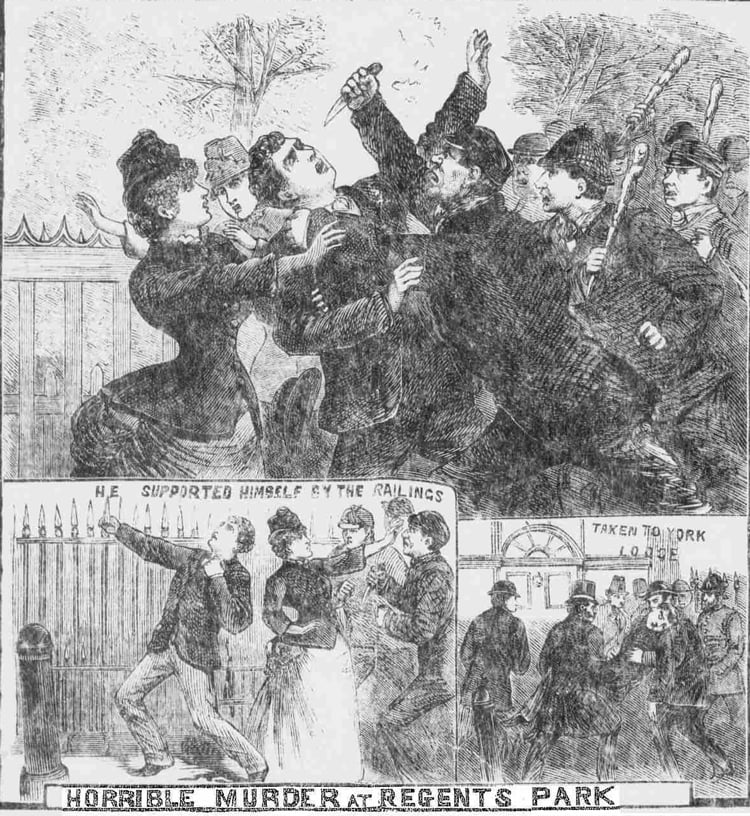
THE REGENT’S PARK MURDER
On Saturday 26th May, 1888, The Globe provided the following update on the case:-
“The additional information which has come to hand about the Regent’s Park murder invests it with an element of mystery.
There does not appear to have been any altercation between the victim and the gang who assailed him. Without any provocation whatever on his part, he was singled out for assassination.
Nor can there be much doubt that the crime was premeditated; the murderer must have had his knife, or whatever the weapon was, in readiness when he sprang on the poor fellow.
All this resembles very closely the doings of the murderous gangs in some Lancashire cities who set forth after dark for the express purpose of stabbing miscellaneously.
AN UNUSUAL FEATURE
In the present case, however, there is one unusual feature.
Before the attack was made, one of the eight roughs said to Rumbold, “Are you Macy?” And then, without waiting for an answer, he was grappled and twice stabbed. No sooner was the crime perpetrated than the whole of the assailants ran away, as if their object had been accomplished; they made no attempt, apparently, to molest any of Rumbold’s companions.
MISTAKEN IDENTITY
It is supposed that he was mistaken for some other person who had incurred the vengeance of the man who killed him.
But, even if this supposition be correct, it is difficult to understand why eight men should need the services of the knife to carry out a casual vendetta of the streets against a fourth of their number. Even the most cowardly rough would consider the odds of four to one in his favour quite sufficient to insure victory.
It is to be hoped that the perpetrators of this atrocious crime will soon be in the hands of the police.
The question “Are you Macy?” ought to give something of a clue to their identity; the person who answers to that name must have a very good idea of who they are.
It appears, too, that one of them mentioned “the Deck ” – Seven Dials – as the locality where the murderer lives, and although this information may have been false, that quarter should be thoroughly searched.
It would be a grave discredit to the metropolis if a murder committed in one of our public parks at a time when a good many people were about, should baffle the Criminal Investigation Department.”
BRUTAL MURDER IN REGENT’S PARK
Under the above headline, Reynolds’s Newspaper carried a much fuller report of the tragedy in its edition of Sunday 27th May, 1888:-
“A dastardly murder was committed in the outer circle, Regent’s-park, on Thursday night.
The victim was a young man named Joseph Rumbold, aged twenty-two, residing at 9, Bridport-street, Blandford-square.
Rumbold was a compositor, employed at Messrs. Henderson, Rait, and Spalding’s printing establishment, Marylebone-lane.
For some weeks past he and a friend named Byrne, also a compositor at Messrs. Henderson’s, had been in the habit of walking about with two work-girls named Lizzie and Annie Lee, living in Barrett’s-court, Marylebone.
On Thursday evening, at eight o’clock, Rumbold and Byrne, after leaving work, met the two sisters as usual, and all four walked along Wigmore-street and Harley-street to the outer circle of Regent’s-park.
Rumbold was accompanied by Lizzie Lee, and Annie had Byrne for a companion.
SET UPON BY THE GANG
On reaching Cornwall-terrace, Rumbold was accosted by a gang of eight or more young fellows, with two or three of whom, it is said, he was intimately acquainted.
Some high words passed, and during the altercation which then ensued Rumbold was set upon by one or more of the gang and struck violently in the neck and back with some sharp instrument such as a large pocket knife.
At the moment the attack was made upon Rumbold, Byrne was about thirty yards behind, and owing to the bend taken by the park railings he was unable to see what was going on in front.
HE HAD BEEN STABBED
However, after having gone a few paces, he was surprised to see that Rumbold had left his sweetheart and was running towards him.
He at once went towards him, when Rumbold staggered and fell at his feet, just beside the railing of York-gate.
On lifting him up, he saw that blood was pouring from a gaping wound in his neck, and he at once called for assistance.
A four-wheeled cab was procured, and the injured man was placed in it, and conveyed to the Middlesex Hospital, where the house surgeon pronounced life extinct, the stab on the back of the neck having penetrated the vertebral column.
WAS JEALOUSY THE MOTIVE?
The case has been placed in the hands of Inspector Robson, of the Criminal Investigation Department.
It is believed that jealousy is the motive for the crime.
Detective-inspector Robson and Detective-sergeant Pugsley, with the other officers of the Criminal Investigation Department, believe that they will very soon bring the perpetrator to justice.
They were busy with their investigations in Lisson-grove and the vicinity, but up to a late hour last night no arrests were made there.
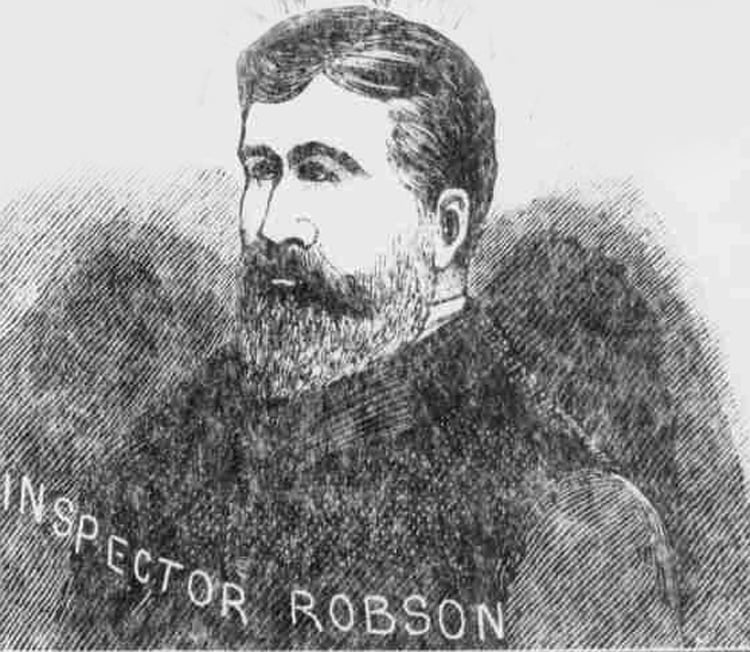
NEW FACTS HAD COME TO LIGHT
Some further details have come to light with reference to the murder.
One story is that a man named Lichfield, who made a statement to the effect that, on the night of the murder, a man (whose name the authorities at present desire to suppress) came to him and said, “Will you come down to the park to meet a couple of Marylebone boys?”
Lichfield said he had other business to do, and he declined to meet, as suggested, in the park, though he did not then imagine there was any particular motive in asking him the question.
THE MURDER WAS DELIBERATELY PLANNED
It is now evident, from facts which have since come to the knowledge of the police, that the murder was deliberately planned.
It is significant that this man who suggested the rendezvous in the park is now missing from the neighbourhood where he lived. The police are searching for him, and his arrest is only considered a question of time.
LIZZIE LEE’S STATEMENT
Lizzie Lee, the girl who was with Rumbold, has made a brief additional statement in which she said that she could not positively identify the murderer, as when the rush was made on Rumbold she herself was knocked down and bruised.
She heard someone say, “That’s him – that’s Macey,” and, immediately after, a cry came from the deceased, “Oh, I’m stabbed! I’m stabbed! Take me somewhere to a doctor.”
ALONZO BYRNE’S STATEMENT
Alonzo Byrne also made a further statement yesterday.
He states that it was about half-past eight when he, Rumbold, and the two girls met in John’s-court on the night of the murder.
Having chatted for a short time as to where they should go, they decided upon at once going to Regent’s-park-gardens.
The four then went up Wigmore-street, straight through Harley-street into York-gate. Turning to their left, they sauntered on and got to the outside of the park railings.
There they stopped for a brief time, and Rumbold said to Lizzie Lee, “Liz, where will you meet me on Sunday?”
Walking along Cornwall-terrace, and when he got to a turn in the road, Byrne heard a scuffling sound.
When he turned the corner he saw Rumbold struggling with his assailant, as already described.
Rumbold tried to speak when he was put into the cab, but was unable to do so. He pointed to his chest for a moment, sank back in the cab, and expired as the vehicle was going down Harley-street.
STABBED BY TWO MEN
That a murder, though not perhaps of young Rumbold, was premeditated, is now clearly shown, and it is believed that the deceased was stabbed by two men with different weapons.
One blade had passed through the neck from behind, while the second weapon, which it is surmised had a larger blade, entered the back, causing a fearful gash, and penetrating the region of the heart.
The immediate cause of death was syncope from the great loss of blood which ensued.
The victim is said to have “bled like a bullock.”
WARRANT FOR A POST MORTEM
Last night, the coroner for Central Middlesex, Dr. G. Danford Thomas, issued his warrant for the making of a post-mortem examination by the house surgeons of Middlesex Hospital on the body of the murdered youth; and an inquest will he held on the body tomorrow.”
JEALOUSY WAS NOT A MOTIVE
However, over the course of the weekend, the police had, evidently, been very busy and, on Monday 28th May, 1888, The South Wales Echo was able to report that several suspects had given themselves up, whilst some important arrests had also been made.
In addition, it was rapidly becoming apparent that, contrary to previous press reports over the course of the weekend, jealousy was not a motive for the murder, which was now being seen as gang-related; and, tragically, it was now being agreed that the crime had come about as a result of mistaken identity :-
RUMBOLD’S ASSAILANTS GIVE THEMSELVES UP
“In connection with the murder at Regent’s Park, an arrest was made on Saturday at Edmonton.
The man was detained there for a considerable time.
The two girls and the man Byrne who were close to Rumbold when he was stabbed in the Park, could not identify the man who was arrested, and so he was released.
Lizzie Lee, who was with the deceased when he was attacked, denies that jealousy had anything to do with the crime. She suggests that there was a feud between the young men of Seven Dials and those of Lisson-grove, and that Rumbold was mistaken by the “Grove gang” for a “Dials fellow.”
The deceased, when attacked, seems to have been surrounded by a number of men, so it will not be an easy matter to identify the person who struck the blow.
A SUSPECT CHARGED
Three men were arrested on Saturday night in connection with the Regent’s Park murder, and during Sunday four others have surrendered themselves to the police, and confessed to being present when Rumbold was attacked.
They have made a full statement of all they know of the affair.
One of those now in custody is charged with being the actual murderer.
Large numbers of people assembled on Sunday night outside the Albany street police-station, where the men are detained, and the greatest excitement prevailed.
General satisfaction is expressed at the activity of the police.
THE SUSPECTS IN COURT
The prisoners are mere boys, and are apparently of respectable parentage.
At the Marylebone police court before Mr De Rutzen – this morning, eight young men, namely, Wiliam Henshaw (16), Peter Lee, George Gallatley (17), William Joseph Graefe (17), Edward Govier (16), Frank Cole (18), Michael Doolan (15), and William Elvis (16), were charged with being concerned in the murder of Joseph Rumbold in Regent’s Perk, on Thursday evening last.
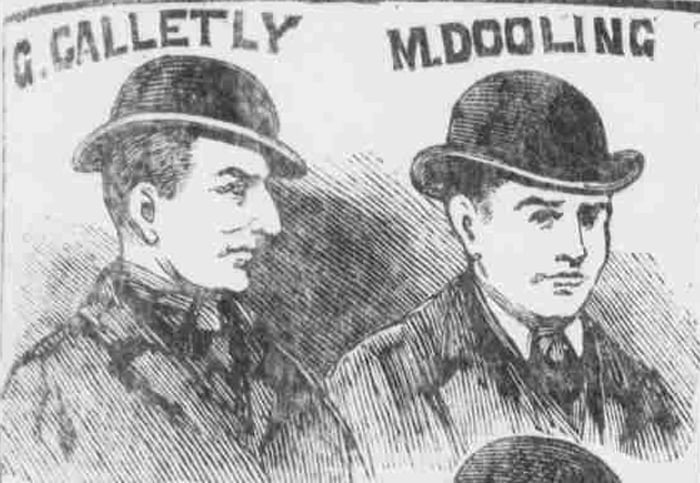
LIZZIE LEE’S EVIDENCE
Elizabeth Lee gave evidence as to the attack, but said she did not see who stabbed her sweetheart, nor could she identify any of the prisoners.
Inspectors Robson, Bannister, and Hale deposed to arresting four of the prisoners.
The others surrendered, one being taken to the station by his mother to make a statement.
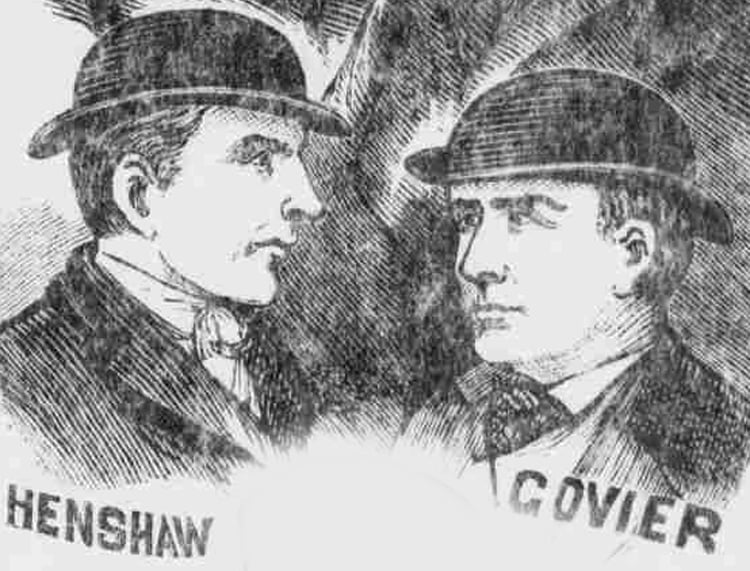
IT WAS PETER LEE’S KNIFE
Peter Lee, when arrested, said the man that did it had his knife, but he did not know his name.
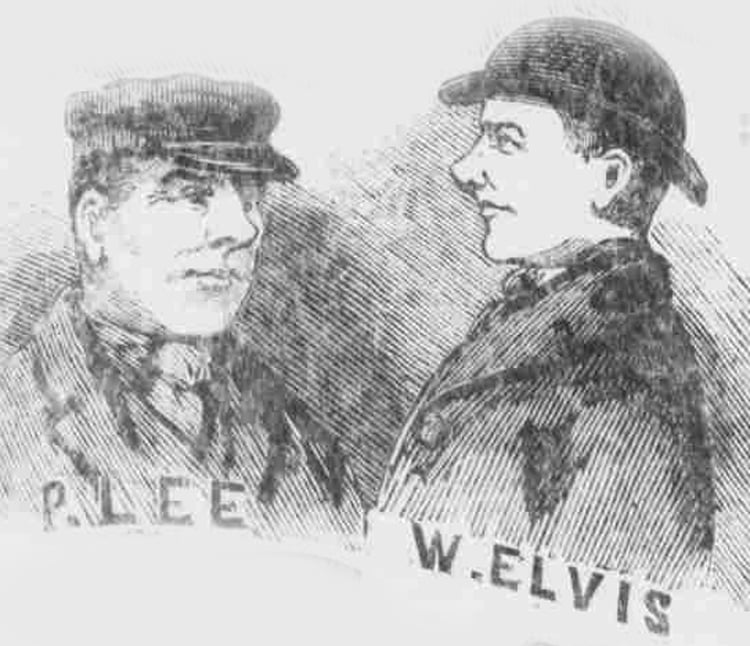
REMANDED FOR A WEEK
Only four of the prisoners had legal advisers.
Graefe’s solicitor urged that there was no case against his client, but all were remanded for a week.”
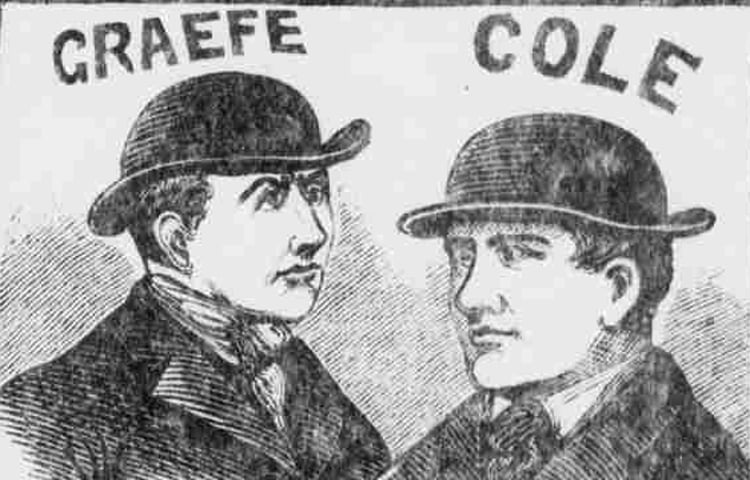
REGENT’S PARK MURDER – THE KNIFE FOUND IN A SEWER
On Friday 1st June, 1888, The Sheffield Evening Telegraph reported that the murder weapon had been discovered:-
“The knife with which Joseph Rumbold was stabbed has been found in the sewer in Upper Rathbone Place.
It is a long dagger sheath-knife, like those generally worn by sailors.
The blade is six inches long, and pointed at the end.
The sewer was searched by the sanitary authorities of Marylebone Vestry, at the request of the police, and the knife was found embedded in the mud.
It belongs to Peter Lee, the sailor, who has stated that he lent it to Galletly.”
THE FUNERAL OF JOSEPH RUMBOLD
The funeral of the victim, Joseph Rumbold, took place at Finchley on Friday 1st June, 1888.
According to a report that appeared in Lloyd’s Weekly London Newspaper on Sunday 3rd June 1888:-
“The departure of the cortege was witnesses by large crowds of sympathisers, and at the cemetery gates eight men who had worked with Rumbold, and with whom he was most intimately acquainted, carried the coffin to the grave.
Messrs. Henderson, Rait and Spalding, the deceased’s employers, gave their men half-a-day’s leave, in order that they might attend the funeral.”
AN ATTEMPTED RESCUE
That same edition of Lloyd’s Weekly London Newspaper also provided further details of the arrests of those who were suspected of having carried out the attack, and mentioned an attempted rescue of the person who was suspected of having wielded the blade that killed Joseph Rumbold:-
“Detective-inspector Robson, D division, said that at half-past 10 on Saturday night he saw Galletly outside a public-house in Charlotte-place, Tottenham-court-road. He asked him his name, and he replied, “Brown.”
When arrested for the murder he said he knew nothing about it.
In Colville-court an attempt was made to rescue him, and the prisoner struggled violently.
Immediately before the attempted rescue some one exclaimed, “That is Garry,” and the prisoner said, “Yes: Clarey and Browny have turned ‘coppers (policemen) to try and hang me.”
LEE PROTESTED HIS INNOCENCE
Detective-inspector Bannister, S division, deposed to the arrest of Lee.
After being charged he said, “I hope you don’t think I stabbed the man. I know I was with the mob. and the man who did it had my knife, but I don’t know his name. I never spoke to him until that night, and I have not had my knife until now. If I knew this was going to happen tonight I would not have gone to bed. Those other two chaps were there, and they know who stabbed him. I had been at work at the hospital all day.”
THE ARREST OF GRAEFE
At four o’clock the same morning (Sunday) witness went to 29, London-street, and arrested Graefe in bed.
On the way to the station he said, “Well, though I wasn’t there, I think I can throw some light on it. The only one I know by name among the lot is Franky Cole. He was round the park with his girl one night when some chap paid him, so this night they came to me in the fair and asked me to go with them to pay his chap.
Well, they had stood up for me, so I went with them as far as Harley-street, outside the park.
When they began to talk about using the knife I left them. I should know the fellow who had the knife. He is taller than me. I am not of a class who use the knife, but of course they will blame me.
Those two chaps that was with you was there, and they ought to be punished as well. Have you got Franky Cole?”
Witness said, “No.”
GOVIER BROUGHT TO THE STATION
At seven o’clock on Sunday night Govier was brought to the station by his mother.
He was warned that he would be charged, and if he made a statement it would be written down and might be used against him.
ELVIS AND DOOLING GIVE THEMSELVES UP
At half-past seven Elvis and Dooling came to the station in the company of Police-constable 344 D.
Dooling said, “We was with the mob that stabbed the man in the Park, and we want to tell what we know about it.”
Elvis said, “We were not there when he was stabbed, but we went up with them.”
The usual caution was given them, and they said nothing more.
COLE BROUGHT IN BY HIS FATHER
At 11.15 witness was called to the Albany-street station, where he found Cole, who had been brought there by his father.
He was told he would be charged with being concerned in the murder, and he made no reply.
HENSHAW TAKEN INTO CUSTODY
Inspector Hare, Scotland-yard, said he saw Henshaw at half-past three on Sunday afternoon at the corner of Frederick-street, Hampstead-road.
Witness asked if his name was Cole, and be replied that it was Henshaw.
Witness told him he would be detained about the Regent’s-park affair, and at the same time confronted him with a boy named Clarey. The latter said he was one of the mob who ran after the chap after he was stabbed.
Witness sent him to the Albany-street station, and some time afterwards saw him there.
As witness entered, the prisoner said, “I went with them as far as Harley-gate, but did not go into the park.”
Afterwards he added, “I was in the park, about 20 yards from the disturbance, and I heard that a man was stabbed. I saw him put into the cab, and I ran away for fear I might be arrested. I made my way to Middlesex Hospital, but they got there before me.”
When the charge was read to him he said, “I’m as innocent as a baby.”
GOVIER GIVES HIMSELF UP
Later on witness saw Govier at Albany-street. Asked what he wanted, Govier replied, “I am come to tell you all I know about the Regent’s-park affair.”
Witness asked his name, and he told him, and then witness advised him not to say anything, as he would be charged with being concerned in the murder.
Some few minutes afterwards he said, “All I did I stopped the man, and said to him, ‘Do you know Bill Paste?’ and he said, ‘No.’
I saw the others set on him. I never laid my hands on him.”
COMMITTED FOR TRIAL
The eight accused appeared at Marylebone Police Court again on Tuesday, 12th June, 1888, and all of them pleaded “Not guilty.”
They were duly committed for trial at the Central Criminal Court (Old Bailey).
Graef and Henshaw were both granted bail, whilst the others were refused bail and were remanded in custody awaiting their trial.
THE OLD BAILEY TRIAL
At their subsequent trial, which took place before Mr. Justice Hawkins in early August, 1888, the judge instructed the jury to acquit six of the defendants on the charge of murder, and they were, instead, charged with unlawfully conspiring to assemble and commit a breach of the peace and assault, to which they all pleaded guilty and were sentenced to periods of between six and fifteen months’ hard labour.
GALLETLY FOUND GUILTY
This only left them to return verdicts on Peter Lee, whose knife had been used in the killing, and George Galletly, who, according to the others, had been the one who had carried out the actual stabbing.
Indeed, several members of the gang testified that Galletly had boasted to them, shortly after the crime, “I have stabbed him” and that he had “laid one of them out”; whilst some also testified that Galletly had shown them the bloodstained knife with which he had carried out the deed.
Lee was fund not guilty, but Galletly was found guilty, although the jury made a strong recommendation to mercy on account of his youth.
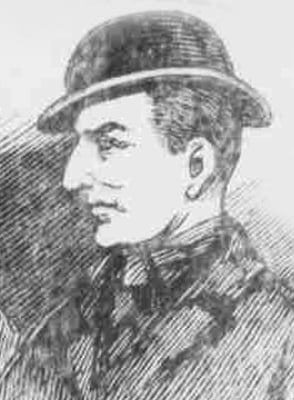
SENTENCED TO DEATH THEN REPRIEVED
The judge, however, sentenced him to death, and the date of his execution was set for the 21st of August, 1888.
But – thanks to a petition organised by Galletly’s Solicitor, Bernard G. Wilson – on the 13th of August, 1888, the Home Secretary, Henry Matthews, informed Galletly, that the death sentence had, in fact, been commuted to one of life imprisonment.
FURTHER INFORMATION
You can read the full transcript of the trial of the accused here.
